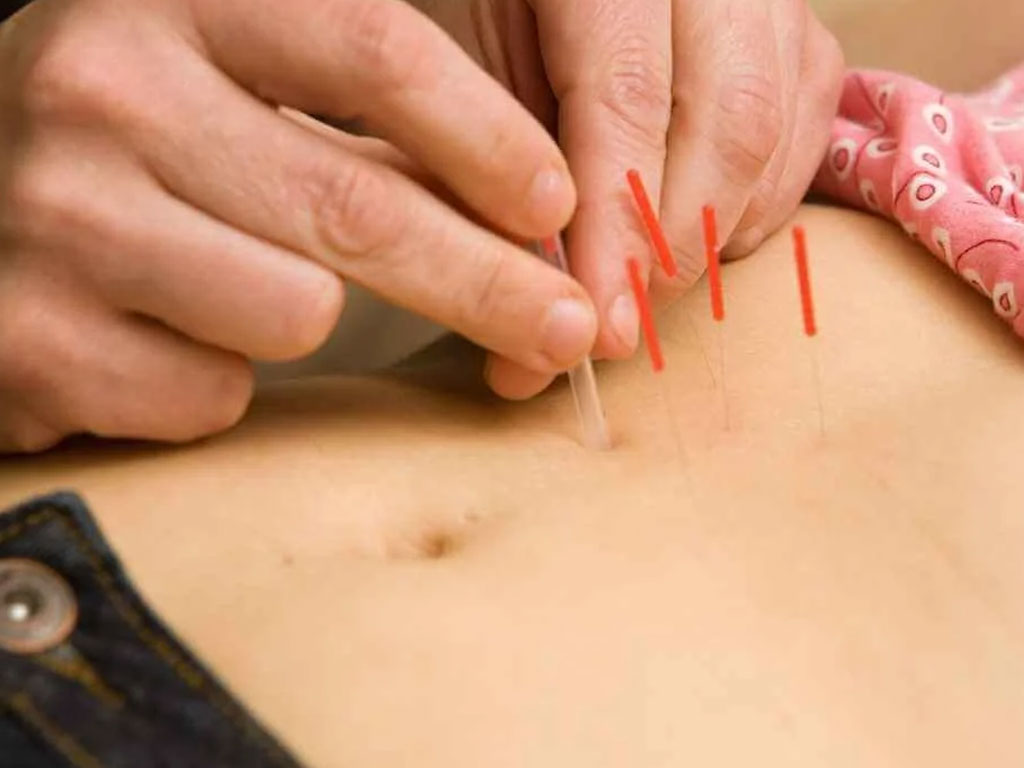Diastasis Recti – Recovery with Advance Pelvic Physiotherapy
The separation of the abdominal muscles from the midline of the stomach, either partially or completely, is referred to as Diastasis Recti, occasionally known as Mummy Tummy.
Studies have shown that up to approximately 60% of pregnant women may experience Diastasis Recti, This occurs due to the expanding of the uterus to make space for a growing child, stretches the abdomen muscles. It is a fairly common occurrence, seeing as about two-thirds of pregnant women experience it. A combination of the increasing size of the uterus, releasing of hormones like Relaxin, and pushing during childbirth can further increase the pressure and stretching of the abdomen muscles.
The pressure that pregnancy can put on the abdomen is sometimes too intense for the muscles in front, causing them to lose form and shape. “Diastasis” refers to the separations, whereas “Recti” refers to the muscle group called the “Rectus Abdominis”.
Although pregnancy is a common cause of Diastasis Recti, it is also possible that both men, and children can experience this, possibly due to over-straining of the abdomen muscles. Occasionally newborn children can experience Diastasis Recti as well, though it is common for it to go away on its own.
What can I do to treat Diastasis Recti?
Some individuals choose to simply live with the separation, if it’s simply minor. However, there is much that can be done to assist with healing Diastasis Recti, especially with the help of a trained pelvic physiotherapist. These muscle separations should be taken care of before the consideration of another pregnancy.

Many women can reduce their belly gap by practicing gentle movements with abdominal support, often aided by wearing a support binder during daily activities. While gentle exercises may be recommended, it's essential to know which ones to avoid if you have Diastasis Recti. Always perform these exercises under the guidance of a pelvic physiotherapist.
Some tips we recommend for those afflicted with Diastasis Recti;
- It is important to avoid doing any heavy lifting, or straining of your abdominal muscles, to avoid further damaging your muscles.
- Remember to practice good posture.
- Avoiding exercises such as yoga postures that stretch the abs, such as “cow pose,” “up-dog,” all backbends, and “belly breathing.”
- Supporting your lower back while you are seated, this can be done by simply placing a towel or pillow behind you.
- Bend your knees, roll, and support yourself with your arm when getting in or out of bed, or standing up off the floor.
Our physiotherapists at Alleviate Physiotherapy are experts in the field of Kegel exercises and strengthening of core muscles that are the foundation of healing Diastasis Recti. If you require any treatment for Diastasis Recti, please contact Alleviate Physiotherapy so that we can begin your journey towards getting rid of Mummy Tummy!
FAQ
Retraining the pelvic floor muscles holds critical importance in treating diastasis recti for several reasons. Firstly, a compromised pelvic floor often accompanies this condition, particularly in women, leading to a host of complications if left unaddressed.
Enhanced Core Stability: The pelvic floor is a crucial component of the core muscle group. Strengthening it helps improve overall core stability, which is essential for closing the gap created by diastasis recti. A stable core supports better posture, reduces strain on the muscles, and aids in recovery.
Reduction of Symptoms: Without proper pelvic floor function, individuals are susceptible to symptomatic issues such as urinary incontinence, organ prolapse, and pelvic pain. Studies indicate that over 70% of women with diastasis recti struggle to perform effective pelvic floor contractions. Addressing these dysfunctions through targeted exercises can alleviate these symptoms significantly.
Improved Muscle Coordination: It’s not just about strength but also about coordination. Retraining focuses on enabling the pelvic floor to engage correctly with the rest of the core muscles. This synchronization is vital for both everyday activities and specific rehabilitation exercises aimed at repairing diastasis recti.
Improved Muscle Coordination: It’s not just about strength but also about coordination. Retraining focuses on enabling the pelvic floor to engage correctly with the rest of the core muscles. This synchronization is vital for both everyday activities and specific rehabilitation exercises aimed at repairing diastasis recti.
By incorporating pelvic floor retraining into a comprehensive treatment plan, individuals not only improve their chances of recovering from diastasis recti but also enhance their overall quality of life, preventing further complications down the line.
Treatment Options for Larger Separations in Diastasis Recti
When dealing with larger separations in diastasis recti—generally considered to be gaps of four finger widths or more—several treatment options are available:
- Supportive Garments
A common non-surgical approach involves using supportive garments, such as corsets or binders. These are typically worn throughout the day and night, except during personal hygiene routines and exercise sessions. They aim to provide stabilization and support for the abdominal area, promoting better posture and enhancing core control during movement.
- Exercise Regimens
Customized exercise programs are often recommended alongside the use of supportive garments. These exercises focus on strengthening the core, improving muscle tone, and addressing postural issues. It’s crucial to follow a regimen guided by a healthcare professional to ensure exercises are performed safely and effectively, reducing the risk of exacerbating the separation.
- Surgical Intervention
For those who have not found relief through conservative measures, surgical options may be considered. One surgical procedure, known as abdominoplasty, might be recommended for individuals who meet specific criteria. This surgery can address the gap by physically bringing the separated muscles together. While it may alleviate symptoms such as lower back pain, the primary benefit is often aesthetic, providing a smoother, more toned appearance.
Each treatment option has its own set of benefits and considerations, and the choice depends on individual circumstances and goals. Consulting with a healthcare provider can help determine the best approach tailored to personal needs.
When it comes to addressing diastasis recti, strengthening the transversus abdominis muscle is crucial. This muscle plays a vital role in core stability and has shown promise as a primary therapeutic target in various clinical research studies.
A strong transversus abdominis can significantly impact the condition by providing essential fascial support to the rectus abdominus muscles. This support helps bring the separated rectus abdominus muscles closer together, enhancing tension in the fascia. As a result, the core becomes better equipped to handle loads during activities like lifting or exercising, offering improved stabilization.
In summary, focusing on strengthening the transversus abdominis is not only beneficial but often a key component of effectively treating diastasis recti, enabling better function and core strength.
Weakened abdominal muscles, particularly due to conditions like diastasis recti, can lead to a range of related health issues. One common problem is low back pain, which occurs because the core’s compromised integrity affects spinal support. Additionally, pelvic girdle pain and pelvic instability are also prevalent as the abdominal and pelvic floor muscles fail to collaborate effectively, impacting load distribution across the pelvis.
Women with diastasis recti might also face pelvic floor disorders. These include problems like urinary incontinence and pelvic organ prolapse, as the lack of muscle support in the abdomen and pelvis disrupts their normal function. Such complications highlight the interconnected roles of the abdominal and pelvic floor muscles in maintaining overall body stability and health.
For individuals facing significant abdominal separation, particularly when the gap measures four or more finger widths, surgery could be an option. Typically, non-surgical methods, such as wearing a corset or binder along with targeted exercises, are recommended first. These support garments are often worn throughout the day, removing them only for bathing and exercising.
However, if these conservative treatments aren't effective, some may explore surgical solutions, commonly known as abdominoplasty. This procedure might be suitable for those who have not seen improvements through exercise and meet other specific criteria.
While surgery can offer relief from some issues like low back pain, it is primarily pursued for its aesthetic benefits, helping to restore the appearance of the abdominal area. It's essential for individuals to consult with healthcare professionals to understand the potential risks and benefits before considering this surgical route.
Yes, diastasis recti can significantly impact your readiness to resume postpartum exercise. This condition involves the separation of the abdominal muscles, which can compromise core strength and stability.
Here’s Why It Matters:
- Core Strength and Stability: A weakened core can lead to imbalances and increase the risk of injury. Exercises that put strain on your abdomen could exacerbate the separation if not properly managed.
- Posture and Alignment Issues: With diastasis recti, the alignment of your spine and pelvis may be affected. This can lead to poor posture, making some exercises challenging and potentially harmful.
- Signs of Readiness:
- Absence of Coning or Doming: When you engage your core, your stomach should not bulge outwards.
- Controlled Movements: You should be able to perform basic movements without pain or difficulty.
- Professional Assessment: Getting evaluated by a healthcare provider can help determine if your body is ready for certain activities.
Considerations Before Starting
- Listen to Your Body: If you experience discomfort or pain, it may be a sign to modify or avoid certain exercises.
- Seek Expert Guidance: Working with a postpartum fitness specialist or physical therapist can provide personalized advice and safe exercise modifications.
Diastasis recti doesn't mean you have to avoid all physical activities, but it does require careful consideration and planning to ensure a safe return to fitness.
Identifying diastasis recti involves observing your abdominal region, especially during certain movements or muscle contractions. Here's how:
- Visual Clues: When engaging in activities like sit-ups or lifting a child, you might notice a distinct bulge along the middle of your abdomen. This is a telltale sign that the abdominal muscles have separated.
- Muscle Contraction: Another method involves feeling the abdominal area with your fingers. When the muscles are contracted, if there's a gap wider than two finger-widths at the center of the abdomen, it indicates the presence of diastasis recti.
These methods provide a practical way to assess if diastasis recti might be an issue, enabling you to seek further evaluation or treatment if necessary.
Pathological levels of diastasis recti, a condition where the abdominal muscles separate, are identified by certain measurements. Typically, if the gap between the muscles at the belly button exceeds 2.7 centimeters, it is considered pathological. This condition often arises immediately after childbirth, affecting over half of all women. In many cases, the separation does not fully resolve without intervention, highlighting the need for awareness and appropriate postpartum care.
Understanding the Impact of Muscle Gap Size and Depth on Abdominal Strength and Function
The separation of abdominal muscles, known as diastasis recti, can significantly impact core strength and functionality. When these muscles split, they diminish functional abdominal strength, leading to muscle imbalance and coordination issues. Recent studies reveal a direct link between the size of the gap beneath the belly button and muscle weakness—larger gaps correspond to weaker muscles, highlighting the importance of gap size in assessing functional strength.
However, it's not just about width. Emerging research suggests that the depth of this gap plays a crucial role as well. A deeper separation can impede the connective tissue, known as the linea alba, from effectively working with muscles to generate tension across the abdomen. This reduced tension capability signals a potential decline in overall abdominal function, suggesting that depth could be a more telling indicator of functional deficiency than previously thought.
This comprehensive understanding of how both size and depth of the muscle gap influence abdominal strength offers valuable insights for addressing and potentially correcting diastasis recti.
In women who have not experienced childbirth, a certain degree of abdominal muscle separation is quite typical. This separation involves the rectus abdominis muscles, commonly known as the "6-pack."
For these women, it is normal to observe around 1 centimeter (approximately the width of one finger) of separation at the level of the belly button. Additionally, a smaller separation of about 0.5 centimeters is expected both above and below the navel.
Understanding these measurements is important for assessing abdominal health and should be kept in mind when evaluating physical fitness or in cases of abdominal concern.
However, there is much that can be done to assist with healing Diastasis Recti, especially with the help of a trained pelvic physiotherapist. These muscle separations should be taken care of before the consideration of another pregnancy.
Seeking professional advice is crucial because:
- Expert Guidance: A healthcare practitioner trained in treating diastasis recti, such as a physiotherapist with expertise in pelvic floor physiotherapy, can provide invaluable expertise.
- Avoiding Risks: Incorrect exercises or improperly performed exercises can be ineffective or, worse, counterproductive and harmful. Professional guidance helps you avoid these pitfalls.
- Personalized Care: Your therapist can create a targeted home exercise therapy program tailored to your specific needs, ensuring a safe and effective rehabilitation journey.
By investing in professional support, you prioritize your health and recovery, setting a solid foundation for any future pregnancies.
Q- How does professional guidance ensure safety during rehabilitation?
A- A trained therapist provides safe guidance throughout the rehabilitation process, ensuring exercises are performed correctly and minimizing the risk of injury or complications.
Q - What can a professional offer in the treatment of diastasis recti?
A- A professional can develop a personalized home exercise therapy program that is specifically tailored to the individual's needs, ensuring targeted and effective rehabilitation.
Q - Why is professional guidance important for diastasis recti treatment?
A- Professional guidance is crucial because incorrect or improperly performed exercises can be ineffective or even harmful, potentially worsening the condition.
Q -Who should you consult for treating diastasis recti?
A- It is important to consult a healthcare practitioner who specializes in treating diastasis recti, such as a physiotherapist with training in pelvic floor physiotherapy.
Some individuals choose to simply live with the separation if it’s minor. However, there is much that can be done to assist with healing Diastasis Recti, especially with the help of a trained pelvic physiotherapist. These muscle separations should be taken care of before considering another pregnancy.
For those experiencing Diastasis Recti, the safest and most effective course of action is to seek advice from a healthcare practitioner trained in this area. A physiotherapist specializing in pelvic floor therapy can be invaluable. They can assess your condition and recommend a personalized treatment plan tailored to your needs.
Many women can reduce their belly gap by practicing gentle movements with abdominal support, often aided by wearing a support binder during daily activities. While gentle exercises may be recommended, it's essential to know which ones to avoid if you have Diastasis Recti. Always perform these exercises under the guidance of a pelvic physiotherapist.
Here are some tips we recommend for those afflicted with Diastasis Recti:
• Avoid heavy lifting or straining your abdominal muscles to prevent further damage.
• Practice good posture to support your core muscles effectively.
• Steer clear of exercises such as yoga postures that stretch the abs, like “cow pose,” “up-dog,” all backbends, and “belly breathing.”
• Support your lower back while seated, perhaps with a towel or pillow.
• Bend your knees, roll, and support yourself with your arm when getting in or out of bed, or standing up off the floor.
Incorrect exercises, or exercises performed incorrectly, can be ineffective or, at worst, counterproductive and harmful. Your therapist should be able to safely guide you through your rehabilitation journey. Our physiotherapists are experts in Kegel exercises and strengthening core muscles, which are the foundation of healing Diastasis Recti. If you require treatment for Diastasis Recti, please contact a qualified physiotherapist to start your journey toward getting rid of Mummy Tummy.
Q- What can a healthcare professional provide?
A- A healthcare professional can develop a tailored home exercise program that specifically addresses your needs, ensuring a safe and effective path to recovery.
Q- Why is professional guidance important?
A- Professional guidance is crucial because exercises that are performed incorrectly can not only be ineffective but also potentially harmful, worsening the condition rather than improving it.
Q- Who should I consult for diastasis recti treatment?
A- It's best to consult a healthcare practitioner with specialized training in treating diastasis recti, such as a physiotherapist experienced in pelvic floor physiotherapy, to ensure effective and safe treatment.
Although pregnancy is a common cause of Diastasis Recti, it is also possible that both men and children can experience this, possibly due to over-straining of the abdomen muscles. Occasionally, newborn children can experience Diastasis Recti as well, though it is common for it to go away on its own.
During pregnancy, some separation of the rectus abdominis muscles naturally occurs as the uterus grows and hormonal changes relax connective tissue. This separation typically begins to recover immediately after birth, with significant progress made between the first day and 8 weeks postpartum. After this period, recovery tends to plateau.
It's important to note that following pregnancy, it's normal for the separation to be as large as 1.5 to 2 cm at the belly button level. More than 50% of women experience pathological levels of diastasis recti immediately following delivery. For many of these women, the recovery of the separation may be incomplete, which can require additional attention or intervention to manage effectively.
This common postpartum condition highlights the importance of understanding the natural progression and the potential need for supportive measures to aid in recovery.
Q- Is postpartum recovery of diastasis recti always complete?
A- For many women, the recovery of the muscle separation after childbirth does not fully complete.
Q- How common is pathological diastasis recti immediately following delivery?
A- More than half of women experience pathological levels of diastasis recti right after giving birth.
Q- What is considered a normal amount of separation postpartum?
A- Postpartum, a separation of 1.5 to 2 cm at the level of the belly button is considered normal.
Q- What is the typical timeline for postpartum recovery of diastasis recti?
A- The recovery generally starts right after birth and continues for up to 8 weeks, after which it tends to stabilize.
Q- What causes the separation of the rectus abdominis muscles during pregnancy?
A- During pregnancy, the separation is due to the expanding uterus and hormonal changes that relax the connective tissues, which naturally leads to the muscles separating.
Have more questions?
A pain-free life is just a call away.
Feel free to Book a Free Consultation
OR
Check out our Services and Therapist Profiles
Your healthcare is our priority; we don’t just Alleviate PAIN, we also Alleviate your QUALITY OF LIFE by improved mobility and daily functioning.









